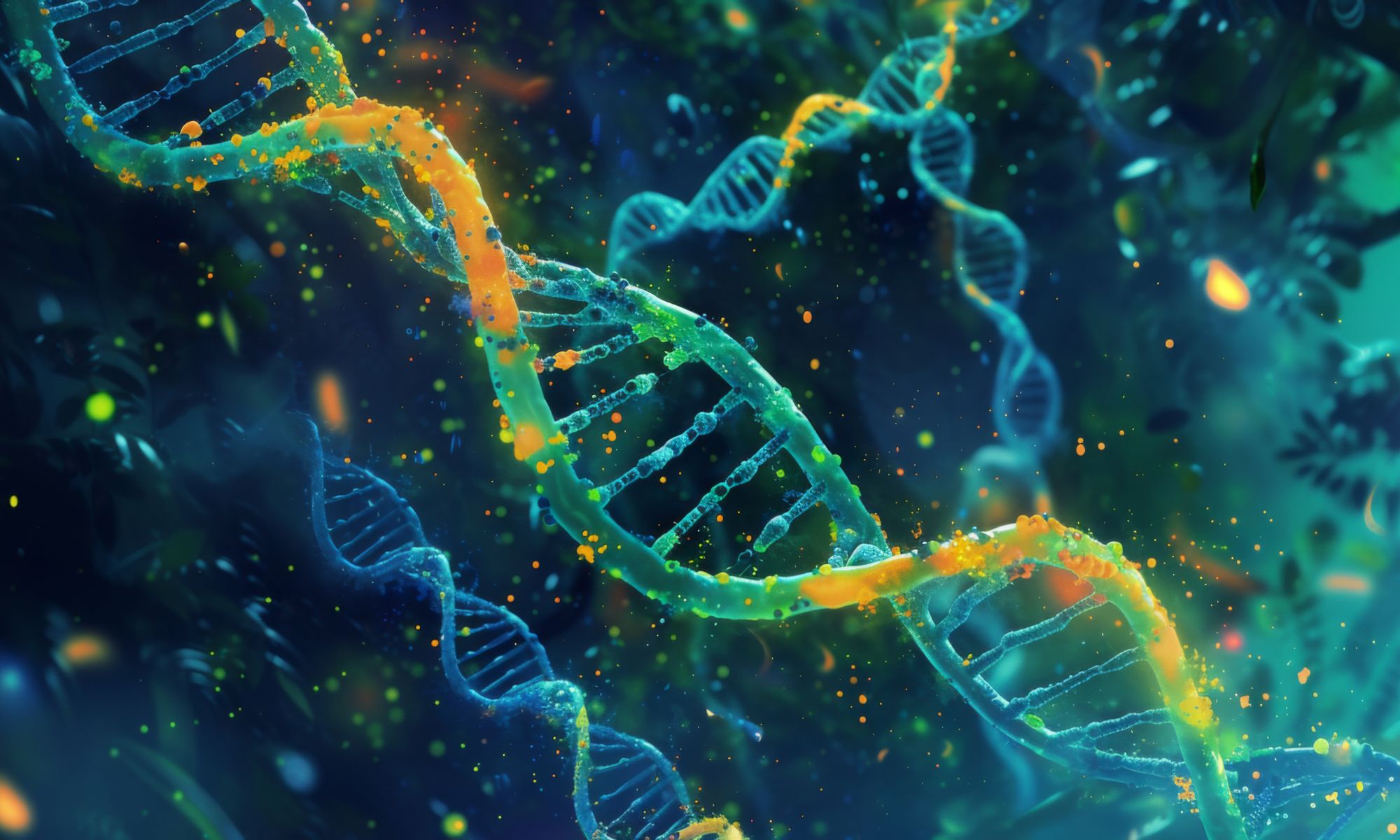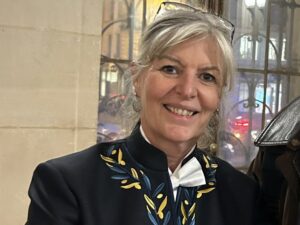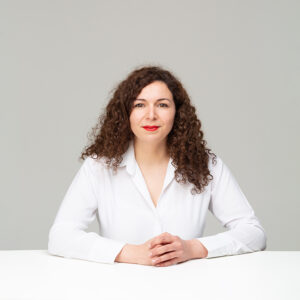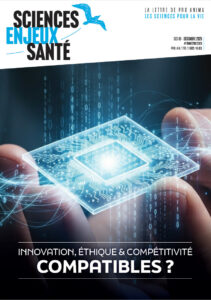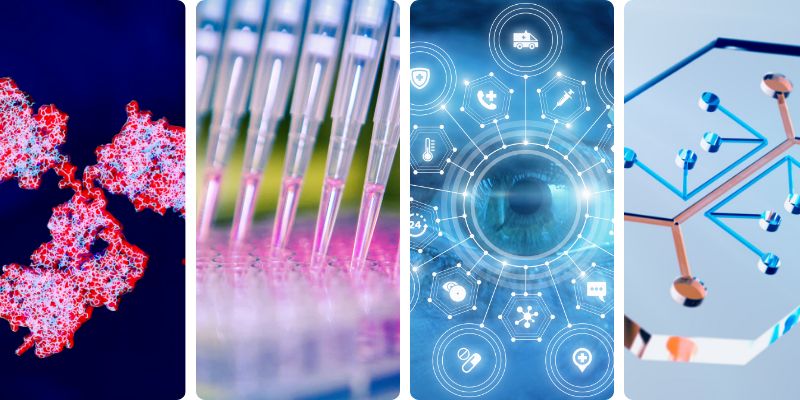Despite medical advances, cancer remains the leading cause of death in France. On April 9, the French National Academy of Surgery held its press briefing on the topic “Environment and Cancer: State of Knowledge and Research Challenges” with presentations by Professor Carole Mathelin, President of the French National Academy of Surgery, and Dr. Meriem Koual, a physician-researcher at the Inserm HealthFex unit. In this interview, these two leading specialists kindly share their expertise on these essential issues.
Pro Anima Scientific Committee: How and why did you become interested in the health-environment issue and which risks/classes of molecules particularly interest you in the context of your work?
Pr Carole Mathelin : Teams specializing in breast cancer care and the French National Academy of Surgery (ANC) are particularly interested in the links between breast cancer and the environment, as the incidence of breast cancer is very high in France, close to that of the United States, Canada, certain European countries, and Australia. Incidence rates are close to or slightly higher than 100/100,000 inhabitants. Although there may be disparities in data collection between these different countries, the findings are worrying in all of them, as approximately 10 to 11% of women will be affected by this disease before the age of 75.
In France, breast cancer is the leading cause of cancer-related death in women. Each year, more than 62,000 women are affected by this disease, and approximately 12,000 die from it. In 25% of these cases, the origin of the cancer can be explained by the presence of known risk factors (including genetic factors). For the remaining 75% of cases, none of these risk factors are identified.
Without collective action to reduce known risk factors, identify new ones, or improve early diagnosis and treatment of breast cancer, the International Agency for Research on Cancer (IARC) has calculated a significant increase in the number of cases and mortality in France (estimated at approximately 20,000 deaths annually over the next two decades).
All this explains the strong involvement of the ANC, most of whose members deal with cancer surgery within the 13 surgical specialties. Advances in one surgical specialty can be useful to other specialties. For example, breast, pancreatic, and prostate cancers have proven links to hormones and therefore to endocrine disruptors in the environment, and progress made in one specialty will be shared with other disciplines.
“In France, breast cancer is the leading cause of cancer-related death in women. In 25% of these cases, the origin of the cancer can be explained by the presence of known risk factors (including genetic factors). For the remaining 75% of cases, none of these risk factors are identified.”
Professor Carole Mathelin
Dr Meriem Koual : I discovered toxicology and environmental health as part of my Master’s degree in 2014, carried out at the INSERM UMR‑S 1124 unit attached to the Université Paris Cité, which focuses on the study of the effects of environmental exposures, particularly chemical pollutants including pesticides and endocrine disruptors, on human health.
Research developed by the laboratory aims to understand the effects of various compounds, alone or in combination, at the cellular and molecular levels (regulation of genes and cell signaling pathways, oxidative stress, inflammation, etc.) and their impact on chronic diseases such as metabolic disorders, neurodegenerative diseases, and cancers. We also seek to identify biomarkers and diagnostic tools to better assess the effects of environmental exposures, and we study innovative strategies to prevent or treat the harmful effects of environmental exposures by identifying therapeutic targets.
For the past 10 years, my work on breast cancer has focused particularly on the effects of persistent organic pollutants, which have specific physicochemical characteristics and which, even though some have been banned for many years, are still very present in our environment. Since this year, I have been working on endometriosis and several pesticides, including chlordecone, but also non-persistent disruptors such as phthalates and parabens, will be studied (Anr ENDOFAT project).
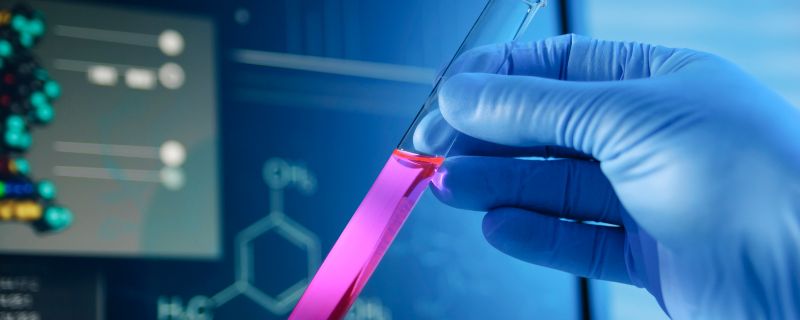
Pro Anima Committee: Among the endocrine disruptors (EDs), apart from those classified 1 or 2a by the IARC (International Agency for Research on Cancer), which ones have a high probability of being tumor promoters and would require particular vigilance in terms of public policy?
Dr Koual : Among the EDs of concern are bisphenol A, phthalates (DEHP, DBP, BBP), parabens, certain emerging pesticides such as neonicotinoids, perfluorinated compounds (PFOA, PFOS), brominated flame retardants (PBDEs), as well as certain metals such as cadmium. These compounds, for which published studies are multiplying, are capable of inducing oxidative stress, modifying gene expression linked to carcinogenesis or tumor progression. Experimental studies have shown that they are capable of increasing cell proliferation, cell migration, invasion, neoangiogenesis or even resistance to apoptosis in various experimental models. Frequent, chronic and multiple exposure of the population to these compounds justifies reinforced regulatory measures and continuous monitoring.
Pro Anima Committee: In our understanding of the complexity of exposures and their physiopathological consequences, do you expect much from the concept of the exposome? How do new approaches and strategies (AI, analytical strategy, omics techniques) contribute to enriching data on the exposome?
Pr Mathelin : In 2005, Dr. Christopher Wild defined the exposome as “the totality of exposures to which an individual is subjected from conception to death. It is a complex and dynamic representation of the exposures to which a person is subjected throughout their life, integrating the chemical, microbiological, physical, recreational, drug, lifestyle, dietary, and infectious environments.”
Breast cancer is an excellent example of the role of the exposome in its occurrence, growth, sensitivity to different therapies, and prognosis. The importance of hormonal exposure (early menarche, late menopause, nulliparity, late pregnancies, certain hormonal treatments, etc.), lifestyle (obesity after menopause, alcohol consumption, a sedentary lifestyle, lack of sunlight or sleep, which increase the risks, etc.), exposure to nighttime light, certain diseases (type 2 diabetes, hyperthyroidism, hemochromatosis, Hodgkin’s disease, etc.), and the chemical environment (endocrine disruptors, PFAS, metals, etc.) have been demonstrated for these various parameters. As the exposome is immensely complex and has a lifelong impact, starting at conception, or even before, new strategies using artificial intelligence (such as the digital platform called Onconum which uses a hybrid method based on machine learning approaches) and omics techniques will undoubtedly enrich its understanding.
“Because the exposome is immensely complex and has an impact throughout life, starting at conception, or even before, new strategies using artificial intelligence and omics techniques will undoubtedly enrich its understanding.”
Pr Carole Mathelin
Dr Koual : The exposome is a concept developed as a complement to the genome; it represents a major determinant of health and well-being, both individual and collective. Since some of these exposures are avoidable, a better understanding of the exposome opens up essential perspectives in terms of prevention. Several initiatives, particularly around the chemical exposome, have helped clarify and operationalize this concept. In this dynamic, the French National Academy of Medicine has formulated recommendations to strengthen consideration of the effects of the exposome on health. These recommendations aim to integrate the notion of the exposome into daily life.
Current technological advances allow for more extensive and precise characterization of the chemical exposome, both in human and environmental matrices. This progress is based on improved exposure measurement tools and a more detailed consideration of the effects associated with complex mixtures of chemical pollutants. These advances also enable a better understanding of the underlying cellular and molecular effects using omics techniques (proteomics, RNA seq, etc.). Available epidemiological data are often incomplete and costly to obtain.
AI offers exciting prospects. The analysis of large datasets, for example, will enable better characterization of exposures and their impacts, as well as modeling in the field of toxicology. Examples include analyses of existing open environmental databases or high-resolution satellite images of large cities, which can be combined with disease registries to explore various risks.

Pro Anima Committee: Are there any concrete examples of progress made thanks to NAMs in terms of prevention, characterization, mechanisms of action, or treatment?
In your opinion, where do France and Europe stand in this field?
Dr Koual : New methodological approaches, or NAMs, have led to concrete advances in several key areas related to environmental health. These approaches, which rely on innovative tools such as toxicogenomics, organoids, high-throughput in vitro tests, and in silico modeling (via bioinformatics analyses), make it possible to identify the toxic effects of certain substances earlier and predict their danger without systematically resorting to animal testing. In terms of prevention, NAMs facilitate better risk assessment, particularly through high-throughput biomonitoring or detailed analysis of the exposome. On the mechanistic level, they make it possible to model signaling pathways and harmful effects via AOP (Adverse Outcome Pathways) schemes, which sheds light on the relationships between exposures and pathological effects. In the therapeutic field, models derived from human cells, such as organoids, offer interesting perspectives for testing substances in conditions close to physiological reality and adapting treatments to the specific response of the individual.
Internationally, Europe is among the leaders in the development and integration of NAMs, particularly through its ambitious environmental health policies (such as REACH, Horizon Europe, or the work of ECHA and EFSA). France is actively involved in this dynamic, with the mobilization of actors such as ANSES, INSERM, and CNRS. However, obstacles remain, particularly with regard to the scientific and regulatory validation of these methods, which still need to gain recognition to replace traditional approaches. Despite this, NAMs are increasingly establishing themselves as essential tools for evolving practices towards a more ethical, rapid, and predictive assessment of health and environmental risks.
Pro Anima Committee: The European Commission is currently developing a roadmap for a phase-out of animal testing for chemical risk assessment. How could physicians and surgeons involved in the environment-health nexus contribute to this important project?
Pr Carole Mathelin : Aside from ethical issues, animal studies are very different from those of humans when it comes to the impact of the exposome or the environment on health. The repercussions of social life, professional activity, medication, travel, stress, etc. throughout life (with a life expectancy of over 80 years) obviously cannot be analyzed on animals. Most doctors/surgeons are very much in favor of the gradual elimination of animal testing in this context.
For example, research supported by the ANC aims to study the correlations between endocrine disruptors and breast cancer in a cohort of 3,600 tumor and/or peritumoral samples from patients operated on for breast cancer or for a benign breast pathology or a surgical risk reduction strategy. The patients are included in the cohort called Senometry (NTC02810093). Participants in this study sign an informed consent that authorizes surgeons to use a very small part of their breast tissue for research purposes. For all these women, samples of cancerous or non-cancerous tumors and their peritumoral tissue are sent to expert laboratories for assaying a wide range of endocrine disruptors (pesticides, PFAS and metals) to better understand the links between environment and breast health. The role of surgeons is therefore essential.
Dr Koual : Physicians and surgeons involved in the environmental-health field can play a key role in the transition to risk assessment. Our clinical expertise can help guide research priorities related to observed pathologies. By collaborating with researchers, we can enable better integration of clinical data into research questions. We can participate in the validation of new methods (in vitro, in silico) by evaluating their relevance to our patients. By participating in the integration of environmental data into medical records and care, we can help better characterize actual exposures and better take individual susceptibilities into account. We also have an important role to play in training and raising patient awareness. In my opinion, our role is important in strengthening the human, preventive, and personalized dimension of chemical risk analysis.
“Physicians and surgeons involved in the environmental health field can play a key role in the transition to risk assessment. Our clinical expertise can help guide research priorities related to the pathologies observed.”
Dr Meriem Koual
Pro Anima Committee: Sensitive populations (pregnant women, infants, children, the elderly, diabetics, etc.) are not always sufficiently considered in preclinical and clinical studies. How could NAMs fill this gap? What role can the precision medicine approach play in these risk assessments?
Dr Koual : NAMs could offer innovative tools to better account for sensitive populations, often neglected in traditional studies. By using adapted human models (cells, organoids, omics data), they could assess specific effects according to age, sex, or certain pathologies. In silico simulations could integrate varied physiological profiles, such as those of pregnant women or the elderly. These approaches would reveal differences in vulnerability to chemical substances. Combined with precision medicine, they would make it possible to identify at-risk subgroups and adapt assessments and prevention measures. This strategy would strengthen the relevance of assessments for public health. It would contribute to more targeted, personalized, and equitable prevention. Thus, NAMs and precision medicine would make risk assessments more realistic, inclusive, and focused on the real needs of populations.
Pro Anima Committee: The National Academy of Surgery appears to have a strong desire to communicate with different audiences. What issues does the Academy wish to highlight, particularly in terms of information and prevention for patients and civil society? How do you envision this implementation?
Pr Mathelin : The ANC enthusiastically communicates regularly (with the global community of surgeons every Wednesday afternoon, with the general public during field meetings, with political decision-makers, etc.) to support, promote and disseminate the excellence of French surgery and its progress. The ANC supports the profound changes in patients’ surgical pathways (with the development of outpatient, robot-assisted, virtual reality-guided surgery, or even the use of outpatient surgery or non-medicalized transitional accommodation) by ensuring that all surgical talents (whether academic or not) can express themselves on their innovations and news, during regularly organized press briefings.
In its communications, the ANC aims, in the current period when the surgical profession is being disrupted by technological, institutional, and societal developments, to anticipate and support these changes by explaining them and taking into account the social, economic, and demographic factors of our society. For example, our elders will create new challenges that will require innovative communication solutions. Our ambition, through our communications, is also to contribute to reducing inequalities in access to care, so that the benefits of tomorrow’s surgery are equitably accessible. Finally, environmental issues will lead us to more efficient resource management, waste reduction, and communication on the integration of eco-responsible practices into our activities, particularly in our operating rooms.
The ANC constitutes a strong and united surgical community dedicated to the health of all, whose expertise must be accompanied by outreach to the healthcare community and the general public.
Pro Anima Committee: How do you imagine your research work and risk assessment in France and Europe if we were to make a projection in 10 years?
Pr Mathelin : Many arguments are currently being put forward in favor of a link between endocrine disruptors and health, but current research suffers from five major pitfalls that will likely be corrected in the next 10 years, thanks in particular to the evolving expertise of data scientists and the involvement of healthcare professionals:
- The majority of studies on this subject have been conducted on in vitro and animal models, thus far removed from humans, particularly concerning the impact of the exposome. Clinical studies will answer our questions about health-environment links. The study of endocrine disruptors in pathological tissues will allow us to understand their tissue targets and therefore their consequences on the progression of the disease and its curability.
- There are epidemiological studies on health-environment links, but the data are often obtained retrospectively using questionnaires, resulting in multiple biases, particularly memory bias. It will be necessary to encourage the obtaining of prospective and exhaustive recording of data, by promoting the security of these very large health databases.
- Furthermore, these studies are most often short-term and do not allow for analysis of treatment responses, nor of recurrence or death rates due to insufficient follow-up or loss to follow-up. Prospective and comprehensive data recording should be encouraged, with a focus on long-term data collection.
- There are no human studies analyzing a large number of pesticides, PFAS, metals, and the various components of the exposome in general, to understand their interactions, their “cocktail” effect, or their “dose” effect. New technologies will enable these combined multiparametric analyses.
- Finally, most clinical studies focus on adults without comorbidities or multiple pathologies, regularly excluding minors, pregnant or breastfeeding women, and the elderly. There are too few clinical studies that allow for the analysis of windows of vulnerability (in utero life, adolescence, pregnancy, menopause, old age) or the involvement of other pathologies that must be encouraged at all costs in the future…
Future technologies, involving the collection, security and analysis of data, combined with transdisciplinarity, should make it possible to identify previously unknown causes of illnesses and provide evidence of the supposed correlations between environmental toxins and health, thus promoting support for public health and prevention actions integrated into the framework of environmental health.
“Risk assessment will become more integrated, dynamic, and predictive, thanks to the exploitation of large environmental, epidemiological, and toxicological databases, combined with AI and mechanistic models”
Dr Meriem Koual
Dr Koual : In 10 years, we can imagine that research and risk assessment in France and Europe will have evolved profoundly, driven by technological advances, strengthened environmental policies, and the rise of the exposome concept. Risk assessment will become more integrated, dynamic, and predictive, thanks to the exploitation of large environmental, epidemiological, and toxicological databases, combined with artificial intelligence and mechanistic models (AOP, multi-scale systems).In silico and in vitro approaches will have become the norm in many fields, largely replacing animal testing. The tests developed will make it possible to rapidly explore the effects of thousands of substances, including combined effects (cocktails) and impacts at low doses or in the long term.
We hope that human biomonitoring will be strengthened through wearable sensors, multi-omics analyses (genomics, metabolomics, proteomics, etc.), and real-time exposure monitoring platforms, which will be integrated into the patient’s medical record. These tools will enable a personalized approach to risk assessment, taking into account individual factors such as age, gender, comorbidities, and lifestyle.
I hope that risk assessment in 10 years will not only be faster and more reliable, but also more humane, preventive, and adapted to the environmental challenges of the 21st century, in a context where health and the environment will be recognized as inextricably linked.
Professor Carole Mathelin, a renowned French surgeon, is the first woman elected president of the French National Academy of Surgery. Specializing in breast and gynecological surgery, she is particularly recognized for her expertise in conservative surgery, which aims to preserve patients’ quality of life while providing effective treatments.
In addition to her practice, Carole Mathelin is a researcher in the Molecular and Cellular Biology of Breast Cancer team at the IGBMC (Institute of Genetics and Molecular and Cellular Biology), actively contributing to advancing scientific knowledge and improving the prognosis and quality of life of women facing breast cancer.
Dr. Meriem Koual is a physician-researcher specializing in gynecological and breast oncological surgery with particular expertise in breast cancer.
Since 2014, she has been conducting translational and fundamental research at the INSERM HealthFex unit (UMR‑S 1124, Université Paris Cité) on the impact of environmental contaminants (persistent organic pollutants, cigarette smoke, food additives) on the metastatic progression and aggressiveness of breast cancer. Her research is based on a multidisciplinary approach combining epidemiology (METAPOP cohort), experimental models, and in silico analyses.

